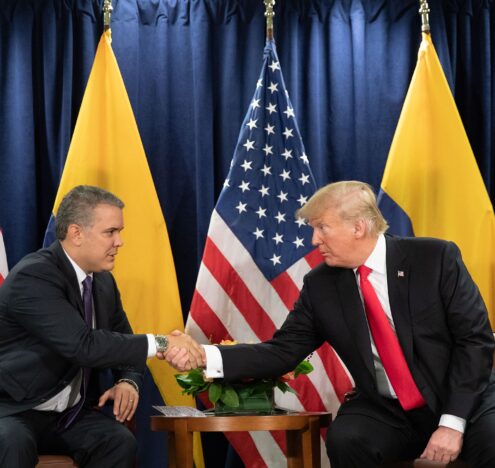Conventional wisdom holds that foreign policy is not a major driver in US elections. While foreign policy has made headlines this election, it remains focused on conflicts abroad or on addressing great power competition with Russia and China. Yet, whoever becomes the next US president will have a major impact on the nation’s foreign policy.
The outcome could acutely impact relations with Latin America and the Caribbean, although US foreign policy has largely sidelined the region and it remains under-discussed in this election. Despite this trend, a consensus among US policymakers on what the key issues are for US Hemispheric affairs has started to emerge.
Key differences remain in how a Donald Trump or Kamala Harris administration might address these issues — differences that will have a real impact on their effectiveness and on the future of Inter-American affairs, as well as on the lives of millions of people across the region.
The Forgotten Partner
Since the turn of the 21st century, Latin America and the Caribbean have rarely been a core focus of US foreign policy or interest. This is for a variety of reasons: there are no military conflicts in the region — albeit high levels of violence remain; the region lacks any major geopolitical powers vying for influence; and although what happens in the region impacts the United States, the broader public is generally disinterested in Latin America relative to other global hotspots.
Ignoring Latin America and the Caribbean has not always been the case and represents a missed opportunity for the United States. Given the region’s proximity, shared history, and economic ties, US foreign policy used to focus heavily on inter-American relations and there was greater interest from the US general public on what happened south of the border. These ties continue to exist today. Many of the challenges facing the United States — from climate change and racism to organized crime and democratic backsliding — threaten Latin America and the Caribbean as well. These challenges require collective action and the United States can learn from the experiences of its neighbors.
Afterthought
Although both the Trump and Biden administrations had active foreign policy toward the Americas, neither of the last two administrations focused on it.
In Trump’s National Security Strategy, the section on the Western Hemisphere made up less than one of its 55 pages (with two other brief mentions within the broader strategy of the region). While the Americas received more real estate in Biden’s National Security Strategy — with two of the 48 pages devoted to the region — it remained an afterthought for the administration.
In fact, Secretary of State Anthony Blinken’s recent treatise on the successes of the Biden administration’s foreign policy, only mentioned Latin America or the Western Hemisphere three times. This lack of clear focus on the region from either administration has led analysts from the region to note that US-Latin American foreign policy is increasingly militarized and being led by US Southern Command (SOUTHCOM). Viewing it purely through SOUTHCOM’s perspective shapes US policy toward the region in critical ways and shapes how governments and citizens interpret US engagement.
No Clear Strategy
Despite — or perhaps because of — the lack of interest in Latin America and the Caribbean, a bipartisan consensus on what the most pressing issues for US relations with the region has started to emerge. These include the need to tackle irregular immigration, address the rise of Chinese influence in the Americas, a bipartisan shift in trade policy, and concerns over democracy in the Americas.
Neither the Trump nor Harris campaign have presented a clear strategy as it relates to the Western Hemisphere. Both campaign websites only mention the region in relation to immigration. Instead, analysts have had to rely on those that have worked with them in the past — as well as their past actions in office — to detail their approach to the region.
While there is overlap in their approaches, how these policies are addressed and framed will have serious implications for the future of inter-American affairs.
Addressing Immigration
Immigration has become one of the most critical components of the 2024 election and, although the conversation often focuses on how it impacts US citizens, the solutions have deep implications for US-Latin American foreign policy.
The vast majority of migrants to the United States are in the country legally and the mix of where immigrants are coming from has shifted — with a sharp decline in the number of migrants coming from Mexico toward migration from South America and other regions of the globe. Although a consensus on the need to address immigration has emerged, the discussion has largely focused on illegal immigration and border security with a focus on the domestic impacts of migration on labor and housing costs.
Since the beginning of his 2016 presidential campaign, Trump has taken a hardline on immigration. Much of this has focused on securing the border and deporting migrants. During his tenure, he was able to cooperate with the Mexican government to slow migration, but the racialized language he used against immigrants also drew the ire of regional governments and negatively impacted perceptions of the United States.
Slow Migration?
In a second term, Trump has promised to ramp up deportations and his running mate, JD Vance, has suggested that the administration might seek to tax remittances to the Americas. While this will continue to impact perceptions from the region, mass deportations from the United States will place large fiscal and political burdens on receiving countries which will simultaneously see a decline in fiscal space if remittances — which accounted for $160 billion to the region in 2023 — are taxed and decline.
Kamala Harris was tasked with addressing the root causes of migration in the Northern Triangle — Guatemala, El Salvador, and Honduras — during the Biden administration. While some have noted that she seems to have turned away from this assignment in the latter half of the term, important steps to engage with the region did occur, including developing the Partnership for Central America, which has generated more than $5 billion in private-sector commitments to promote opportunities in the region.
Harris also supported, and continues to support, bipartisan immigration legislation. While this approach will still strain neighbors, it is likely to create less backlash from the region by providing financing to slow migration rather than just applying costs.
The Rise of China
Chinese trade with the region has ballooned in the 21st century, with trade growing from about $18 billion in 2002 to over $450 billion in just 20 years. China has also expanded its foreign policy toward the region.
One place where this is evident is in its engagement with regional organizations where it engages with at least 19 different organizations or forums within the Americas. Latin America and the Caribbean remain a thorn in the side of the One-China Policy on recognition vis-a-vis Taiwan — of the 12 countries that still recognize Taipei, seven are in Latin America and the Caribbean.
To shift this, China has been accused of conducting “Checkbook Diplomacy” to use foreign aid — and even offering COVID-19 vaccines to Paraguay — to urge countries to change recognition. Chinese engagement has also supported undemocratic leaders in countries like Cuba and Venezuela.
Renewed Monroe Doctrine?
In addition to Beijing’s economic and political impact, there is increasing concern about the security implications of Chinese engagement in the Americas. This has included concerns over Chinese contracts to operate major ports, Chinese engagement in space programs and infrastructure, and the expansion of Chinese tech companies in Latin America’s digital infrastructure. Not only are there concerns for how this impacts regional security but also, given the proximity to the United States, how this could impact US national security.
Politicians from across the political spectrum have kept an attentive eye on the rise of Chinese influence and engagement in the Americas. Some politicians on both sides of the divide have gone as far as to call for a renewed Monroe Doctrine — a foreign policy that aimed to preclude extra-hemispheric influence in the Western Hemisphere. Much of the region views that doctrine as a tool of US imperialism. Whether a Trump or Harris administration comes to power, it will undoubtedly take a hardline stance toward Chinese engagement in the Americas. However, how they approach this will be different.
Reacting to Chinese Influence
During his administration, President Trump took steps to pressure governments in the region to limit engagement with China. While early efforts from the Trump administration focused on chastising Latin American and Caribbean countries for their engagement, the administration moved toward a strategy of providing real alternatives to Chinese overtures — including providing development aid. While the shift was important, it came following several examples of the Trump administration reviving the Monroe Doctrine and prompting pushback from the region.
For its part, the Biden administration has sought to counter Chinese influence through expanded multilateral and mini-lateral approaches, including the Americas Partnership for Economic Prosperity.
During his administration, President Trump took steps to pressure governments in the region to limit engagement with China.
Yet, while the administration has turned toward providing an alternative to China, many initiatives remain framed as anti-China initiatives — a position that may hinder its effectiveness. While Harris may chart her own path to address Chinese influence, given the bipartisan pressure to counter China, she will likely continue a similar path forward.
One challenge that either a Trump or Harris administration will face in competing with China’s appeal in the region is the shift in US preferences surrounding trade. As many countries in the region, such as Ecuador and Uruguay, look to expand their trade relationship with the United States and even seek free trade agreements, they end up turning toward China as an alternative to the US market.
Trade
Although the US has a long history of promoting regional economic integration, US preferences have shifted away from trade promotion. As far back as the first Pan-American Conference in 1889, the United States pushed for regional integration in the form of a shared customs union and monetary system. While these efforts did not materialize, the US continued promoting trade as critical to regional affairs.
In fact, following the passage of the North Atlantic Free Trade Agreement (NAFTA), countries from across the region agreed to push for a hemisphere-wide Free Trade Agreement of the Americas at the First Summit of the Americas. While this also failed to materialize, of the 20 countries that have free trade agreements with the US, 12 are in the Americas.
Meanwhile, US interest in free trade agreements has soured. In the 2016 election, major candidates from both parties campaigned on more protectionist measures, and today there is little appetite for promoting a free trade agenda. However, the COVID-19 pandemic highlighted weaknesses in global supply chains. This, coupled with efforts to curb Chinese influence in the Americas, particularly in trade, has led to a growing consensus on the need to promote supply chains within the Americas through nearshoring and friendshoring.
Nearshoring
Both the Trump and Biden administrations took steps to deepen trade and nearshore supply chains within the Americas. The Trump administration launched the America Crece Initiative in 2019, and the Biden administration announced the Americas Partnership for the Americas (APEP) at the Summit of the Americas in 2022.
Earlier this year, a bipartisan set of members of Congress introduced the Americas Trade and Investment Act that further institutionalizes efforts to promote nearshoring efforts. Many of these efforts have been framed as efforts to counter China rather than through purely economic benefits, which may dampen their impact on countering China. Nonetheless, nearshoring itself promises important economic benefits to countries across the Americas.
While Trump’s campaign promises around trade suggest that he may seek to apply broad-based tariffs that would impact countries across the Americas, concerns over China and presentations from Trump world advisors suggest that he may continue to push nearshoring as a strategy. Similarly, with reporting that the Harris administration is listening closely to Biden administration economic advisors, it is likely that a Harris administration would also continue to push this agenda.
While which countries are the greatest beneficiaries of nearshoring is likely to vary by administration, and the Trump administration may limit some of the nearshoring opportunities through a universal tariffs scheme, regardless of who wins the presidency, US efforts to move forward with nearshoring as a central feature of US-Latin American foreign policy are likely to continue.
Promoting Democracy
Since the turn of the 21st century, threats to democracy in Latin America and the Caribbean have transformed. While military coups, a problem that plagued the region through the 19th and 20th centuries, have largely become a thing of the past, democracy remains under siege.
New threats include efforts to concentrate power through constitutional rewrites, executive aggrandizement, attacks on media, ignoring and terminating term limits, and attempting to prevent democratic transitions of power. Just this past year, Freedom House reported declines in freedom in nine countries across the Americas.
Given these trends, it should come as little surprise that the decline in democracy has received attention from both sides of the political spectrum. Of course, different US politicians have seen the decline in democracy through partisan lenses.
The Trump administration was an outspoken critic of dictatorships in Cuba, Nicaragua, and Venezuela — a set of countries that a Trump official named the “Troika of Tyranny.” The administration was also a staunch supporter of Juan Guaidó’s interim presidency in Venezuela and his attempt to oust the Maduro regime.
The administration was quick to condemn the Troika and “communism,” but it failed to raise concerns about other undemocratic actions and even lauded some in various countries. For example, despite concerns over former Brazilian President Jair Bolsonaro’s undemocratic tendencies, Trump embraced Bolsonaro, much as he did with strong-man leaders in other parts of the world.
Differences in Defense of Democracy
The Biden administration has made support for democracy a cornerstone of its foreign policy, even going so far as to host summits on democracy in recent years. The Biden administration, including Vice President Harris’s team, played a crucial role in ensuring that democratic transitions occurred in both Brazil and Guatemala.
In both cases, the administration effectively leveraged both multilateral and bilateral pressure to ensure that the transitions occurred. Still, while the administration has spoken out about clear violations of democratic principles (like in Venezuela), it has been less than eager to condemn democratic backsliding in countries like El Salvador.
While either a Harris or Trump administration will rhetorically support democracy in the region, there will be very real differences in how and where they defend democracy. Political, geopolitical, and economic considerations may limit where either administration seeks to condemn undemocratic action, but a Harris administration will be unlikely to openly embrace undemocratic leaders in the way Trump did during his previous administration. As democratic crises continue to evolve in the region, supporting democratic nations regardless of domestic or international political considerations will be critical to ensuring that democracy in the region does not continue to erode.
Rhetoric on Hemispheric Affairs
The consensus around the rise of China, addressing immigration, shifting toward protectionism and near-shoring, and concerns over democracy in the Americas may be shared and the solutions overlap in many ways between potential Trump and Harris administrations. However, how these are approached and framed by these administrations will impact their ability to cooperate and build partnerships in the region.
The largest difference in their approaches is the gap between the use of threats and the use of enticements. While the Trump administration is more likely to lean into threats and coercive measures, such as sanctions, a Harris administration is more likely to rely on carrots. This approach is likely to boost US soft power and improve perceptions of the United States in the region.
While the Trump administration is more likely to lean into threats and coercive measures, such as sanctions, a Harris administration is more likely to rely on carrots.
The two administrations would also have differences in how they address democratic backsliding in the region. The Trump administration is likely to continue to take a hardline stance against communism while the Harris administration will be more likely to speak out against democratic decline regardless of ideology — albeit while taking political and economic considerations into account.
Security Lens
Their approaches will also lead to different likely partners. Trump is more likely to maintain close relations with leaders the global conservative movement views favorably — such as Argentina’s Javier Milei and El Salvador’s Nayib Bukele, both of whom spoke at this year’s Conservative Political Action Conference (CPAC).
A Harris administration would likely be able to work with these countries — much as the Biden administration has — but it would also be more able to engage with countries with left-wing governments. Working with these countries will be critical to addressing shared challenges in the region and in building support for collective pressure on undemocratic countries. Given Harris’s heritage, past policy preferences, and prosecutorial history, she may also be able to work with Caribbean leaders on issues of importance to the region, including climate change and gun trafficking.
Rhetoric surrounding the region will also have real impacts. Both administrations will likely have a heavy focus on China and view the region through this security lens. This framing may lead to missed opportunities to partner with the region under both administrations. However, a Trump administration is much more likely to engage in conversations of the Monroe Doctrine and racialized discourse surrounding immigrant communities — discourses that can undermine US relations across the region. These conversations also feed into regional concerns about US interests in the region as well as China’s narrative of US intentions.
This article is a revised version of a presentation the author gave to the World Affairs Council of New Orleans on Oct. 28, 2024.
Top Photo: A guest places a photo of a loved one at the White House’s ofrenda to mark Día de los Muertos, Thursday, October 31, 2024, on the East Landing. (Official White House Photo by Abe McNatt)





















